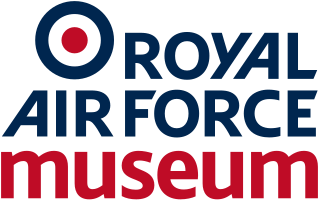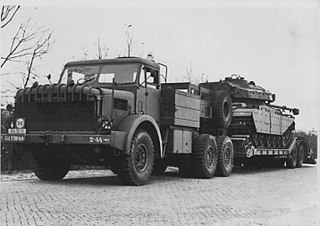

A Queen Mary trailer is a British semi-trailer combination designed for the carriage and recovery of aircraft. The trailer was made by Tasker Trailers of Andover, with Bedford or Crossley Motors tractors.


A Queen Mary trailer is a British semi-trailer combination designed for the carriage and recovery of aircraft. The trailer was made by Tasker Trailers of Andover, with Bedford or Crossley Motors tractors.
Features included:
Load was 5 tons "distributed evenly".
These features were a natural result of the intended load, aircraft being typically light but long. The name is presumed to derive from its length, a reference to the ocean liner RMS Queen Mary.
Nearly four thousand of these vehicles were used by the Royal Air Force and Royal Navy Fleet Air Arm during and after World War II. It also saw service with the air forces of commonwealth air forces, including New Zealand. [1]
Post-war civilian operators included Silver City Airways.

The Westland Wessex is a British-built turbine-powered development of the Sikorsky H-34. It was developed and produced under licence by Westland Aircraft. One of the main changes from Sikorsky's H-34 was the replacement of the piston-engine powerplant with a turboshaft engine. Early models were powered by a single Napier Gazelle engine, while later builds used a pair of de Havilland Gnome engines.

The Fairey Battle is a British single-engine light bomber that was designed and manufactured by the Fairey Aviation Company. It was developed during the mid-1930s for the Royal Air Force (RAF) as a monoplane successor to the Hawker Hart and Hind biplanes. The Battle was powered by the same high-performance Rolls-Royce Merlin piston engine that powered various contemporary British fighters like the Hawker Hurricane and Supermarine Spitfire. The Battle was much heavier, with its three-man crew and bomb load. Though a great improvement over the aircraft that preceded it the Battle was relatively slow, had limited range, and had only two .303 (7.7 mm) machine guns as defensive armament, thus it was found to be highly vulnerable to enemy fighters and anti-aircraft fire.

The de Havilland DH.82 Tiger Moth is a 1930s British biplane designed by Geoffrey de Havilland and built by the de Havilland Aircraft Company. It was operated by the Royal Air Force (RAF) and other operators as a primary trainer aircraft. In addition to the type's principal use for ab initio training, the Second World War had RAF Tiger Moths operating in other capacities, including maritime surveillance and defensive anti-invasion preparations; some aircraft were even outfitted to function as armed light bombers.

The Avro Anson is a British twin-engined, multi-role aircraft built by the aircraft manufacturer Avro. Large numbers of the type served in a variety of roles for the Royal Air Force (RAF), Fleet Air Arm (FAA), Royal Canadian Air Force (RCAF) and numerous other air forces before, during, and after the Second World War.

The Handley Page HP.67 Hastings is a retired British troop-carrier and freight transport aircraft designed and manufactured by aviation company Handley Page for the Royal Air Force (RAF). Upon its introduction to service during September 1948, the Hastings was the largest transport plane ever designed for the service.

The Royal Air Force Museum London is located on the former Hendon Aerodrome. It includes five buildings and hangars showing the history of aviation and the Royal Air Force. It is part of the Royal Air Force Museum.

The Bristol Type 171 Sycamore was an early helicopter developed and built by the helicopter division of the Bristol Aeroplane Company. The name refers to the seeds of the sycamore tree, Acer pseudoplatanus, which fall with a rotating motion. It has the distinction of being the first British helicopter to receive a certificate of airworthiness, as well as being the first British-designed helicopter to be introduced by and to serve with the Royal Air Force (RAF).

The Eurofighter Typhoon is in service with seven nations: United Kingdom, Germany, Italy, Spain, Saudi Arabia, Oman and Austria. It has been ordered by Kuwait and Qatar, with orders for all eight customers still pending as of September 2017. The aircraft has, as of 2016, been provided in a basic air-defense form and has been upgraded to newer production standards which include internal IRST, air-to-ground precision strike capability, and HMSS helmets. Most of the major systems including the CAPTOR radar and the Defence Aids Sub-System (DASS) are expected to be improved and updated over time, with the radar being updated to an AESA, being the CAPTOR-E/CAESAR, of which the Kuwait Air Force will be the inaugural operator, with first deliveries of their 28 new-built aircraft to commence in 2019.

Royal Air Force Elvington or more simply RAF Elvington is a former Royal Air Force station which operated from the beginning of the Second World War until 1992 located at Elvington, Yorkshire, England.

Royal Air Force Gatow, or more commonly RAF Gatow, was a British Royal Air Force station in the district of Gatow in south-western Berlin, west of the Havel river, in the borough of Spandau. It was the home for the only known operational use of flying boats in central Europe, and was later used for photographic reconnaissance missions by de Havilland Canada DHC-1 Chipmunks over East Germany. Part of the former airfield is now called General Steinhoff-Kaserne, and is home to the Luftwaffenmuseum der Bundeswehr, the German Air Force Museum.

Imperial War Museum Duxford is a branch of the Imperial War Museum near Duxford in Cambridgeshire, England. Britain's largest aviation museum, Duxford houses the museum's large exhibits, including nearly 200 aircraft, military vehicles, artillery and minor naval vessels in seven main exhibition buildings. The site also provides storage space for the museum's other collections of material such as film, photographs, documents, books and artefacts. The site accommodates several British Army regimental museums, including those of the Parachute Regiment and the Royal Anglian Regiment.

633 Squadron is a 1964 British / American war film directed by Walter Grauman and starring Cliff Robertson, George Chakiris, and Maria Perschy. The plot, which involves the exploits of a fictional World War II British bomber squadron, was based on the 1956 novel of the same name by former Royal Air Force officer Frederick E. Smith, which itself drew on several real RAF operations. The film was produced by Cecil F. Ford for the second film of Mirisch Productions UK subsidiary Mirisch Films for United Artists. 633 Squadron was the first aviation film to be shot in colour and Panavision widescreen.
The Yorkshire Air Museum & Allied Air Forces Memorial is an aviation museum in Elvington, York on the site of the former RAF Elvington airfield, a Second World War RAF Bomber Command station. The museum was founded, and first opened to the public, in the mid 1980s.

The Mighty Antar was a heavy-duty 6×4 tractor unit built by Thornycroft from the late 1940s onwards. For some decades it was the standard tank transporter of the British Army and was also used by other nations. It was powered by a shortened V8 land version of the V12 Meteor engine, derived from the Merlin and modified to run on diesel, known as the Rolls-Royce Meteorite.

The AEC Matador was a heavy 4×4 truck and medium artillery tractor built by the Associated Equipment Company for British and Commonwealth forces during World War II. AEC had already built a 4×2 lorry, also known as the Matador.

Royal Air Force Twinwood Farm or more simply RAF Twinwood Farm is a former Royal Air Force satellite station located 4 mi (6.4 km) north of Bedford, Bedfordshire, England. For the majority of World War II, the airfield was home to RAF night fighters.

The Sd.Kfz. 7 was a half-track military vehicle used by the German Army, Luftwaffe and Waffen-SS during the Second World War. Sd.Kfz. is an abbreviation of the German word Sonderkraftfahrzeug, "special purpose vehicle". A longer designation is Sd.Kfz. 7 mittlerer Zugkraftwagen 8t, "medium towing motor vehicle 8t".

Towing is coupling two or more objects together so that they may be pulled by a designated power source or sources. The towing source may be a motorized land vehicle, vessel, animal, or human, and the load being anything that can be pulled. These may be joined by a chain, rope, bar, hitch, three-point, fifth wheel, coupling, drawbar, integrated platform, or other means of keeping the objects together while in motion.
The fifth expedition of the Somaliland campaign, which took place in 1920, was the final British expedition against the Dervish forces. Although the majority of the combat took place in January, British troops had begun preparations for the assault as early as November 1919. The British forces included elements of the Royal Air Force and the Somaliland Camel Corps. After three weeks of battle, Diriye Guure's Dervishes were defeated, bringing an effective end to their 20-year resistance.

The Joint Aircraft Recovery and Transportation Squadron (JARTS), informally known as Crash and Smash is a combined Royal Navy and Royal Air Force squadron that is tasked with the recovery and surface transportation of aircraft under the aegis of the British military framework. The squadron operates worldwide, and recovering aircraft from post-crash incidents is a large part of their work. Whilst they are a component of the British military, they may be asked to attend and recover aircraft from non-military incidents as they have a Memorandum of Understanding with the UK's Air Accident Investigation Branch (AAIB).